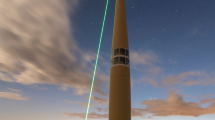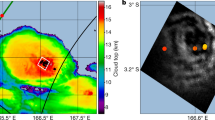Abstract
An eyewitness sees ball lightning as a luminous sphere in regions of thunderstorm activity. There are many reports of ball lightning forming after a lightning discharge, existing for several seconds, and terminating suddenly and silently, or exploding with or without material damage1,2. Jennison3 has described ball lightning observed at close range inside a commercial aircraft shortly after a lightning discharge. As it drifted down the aisle of the passenger cabin, this ball lightning exhibited: (1) perfect equilibrium in a perfectly spherical shape with diameter 22±2 cm; (2) 5–10 W of optical radiation in blue-white light, but no heat radiation; and (3) an optically thick surface of almost solid appearance, devoid of polar or toroidal structure, but with some limb-darkening. It seems unreasonable to dismiss Jennison's ball lightning as an optical illusion4 (afterimage of the eye's retina). A physical explanation in terms of a microwave cavity5, a d.c. glow discharge6, chemical reactions7, nuclear reactions8 or annihilation of antimatter9 runs into difficulties since the all-metal airplane structure would act effectively as an air-tight Faraday cage. A plethora of excited atoms and molecules, and electromagnetic waves ranging from radio frequencies to X rays are produced in the channel of a lightning discharge, but only electric charge itself can enter the interior of an all-metal airplane without difficulty. Here a new model is presented which explains ball lightning in terms of electric charge.
This is a preview of subscription content, access via your institution
Access options
Subscribe to this journal
Receive 51 print issues and online access
$199.00 per year
only $3.90 per issue
Buy this article
- Purchase on Springer Link
- Instant access to full article PDF
Prices may be subject to local taxes which are calculated during checkout
Similar content being viewed by others
References
Singer, S. The Nature of Ball Lightning (Plenum, New York, 1971).
Singer, S. in Lightning Vol. I (ed. Golde, R. H.) (Academic, New York, 1977).
Jennison, R. C. Nature 224, 895 (1969).
Argyle, E. Nature 230, 170–180 (1971).
Kapitsa, P. L. Dokl. Akad. Nauk. SSSR 101, 245–248 (1955).
Finkelstein, D. & Rubinstein, J. Phys. Rev. 135, A390–396 (1964).
Smirnov, B. M. Soviet Phys. Usp. 18, 636–640 (1976).
Altschuler, M. D. et al. Nature 228, 545–547 (1970).
Ashby, D. E. T. F. & Whitehead, C. Nature 230, 180–182 (1971).
Panofsky, W. K. H. & Phillips, M. Classical Electricity and Magnetism (Addison-Wesley, New York, 1962).
Uman, M. A. Lightning (McGraw-Hill, New York, 1969).
Feynman, R. P. The Feynman Lectures on Physics Vol. 3 (Addison-Wesley, New York, 1966).
Abramowitz, M. & Stegun, I. A. Handbook of Mathematical Functions (Dover, New York, 1968).
Anderson, F. J. & Freier, G. D. J. geophys. Res. 77, 3928–3930 (1972).
Jackson, J. D. Classical Electrodynamics (Wiley, New York, 1962).
Dijkhuis, G. C. Proc., 14th Intersociety Energy Conversion Engineering Conf., Boston (1979).
Author information
Authors and Affiliations
Rights and permissions
About this article
Cite this article
Dijkhuis, G. A model for ball lightning. Nature 284, 150–151 (1980). https://doi.org/10.1038/284150a0
Received:
Accepted:
Issue Date:
DOI: https://doi.org/10.1038/284150a0
This article is cited by
-
Relativistic-microwave theory of ball lightning
Scientific Reports (2016)
-
Experimental research on ball lightning
Il Nuovo Cimento C (1990)
-
Plasmoid confinement by the charged particle micro-fields
Nature (1981)
-
Plasmoid confinement by the charged particle micro-fields (reply)
Nature (1981)
Comments
By submitting a comment you agree to abide by our Terms and Community Guidelines. If you find something abusive or that does not comply with our terms or guidelines please flag it as inappropriate.



